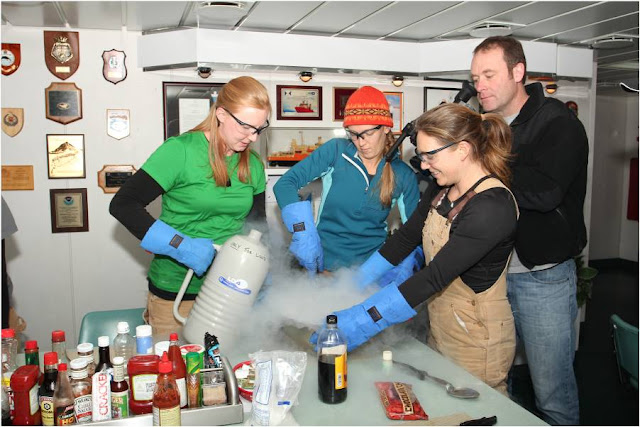Ice
Types 101
When talking about the sea and ice,
one can easily think of Kate Winslet and Leonardo DiCaprio standing on the bow
of RMS Titanic as it meets its destiny in the shape of an iceberg in
North Atlantic, or Bering Sea fishermen
dodging ice floes to catch snow crab, or Happy Feet dancing his way to
happiness. But ice is more than a mere backdrop to a movie or TV show, it
defines the environment that we study and shapes the world that we live in. It
is home to a multitude of
creatures ranging from penguins (in
Antarctica) to polar bears, walrus, narwhal and beluga (in the Arctic). In winter, the formation of sea-ice around Antarctica doubles the size of the continent. Yet ice on
the ocean is simply not a big chunk of frozen seawater and not all ice on the
ocean is sea-ice. There are a variety of names given to different types of sea-ice
and different ice features. At the end of this blog, I’ll explain the most
important type of ice …
Sea-ice formation starts with the
formation of small ice crystals called frazil ice. If the sea is calm,
the frazil ice congeles into a thin film called grease ice, so named
because it has the appearance of an oil slick on the sea surface. As the grease
ice film grows, it thickens into a thin ice sheet called nilas. Wind and
currents can push the nilas sheets on to each other in a process called rafting.
As the nilas ice thickens, it becomes congelation ice. If the sea is
rough, the
frazil ice is pushed together to form
circular shaped pancake ice (or simply pancakes). If the wave
action is strong enough, the pancakes can be rafted together. Eventually, the
pancakes freeze together to form an ice sheet called consolidated pancake
ice. On this trip, we have seen lots of pancake ice.



Small pancakes (up to 1 foot, or 30 cm,
in diameter) with a thick slurry of frazil ice between
them, or as someone on the boat
described it, pancakes and syrup! Photo
credit: P. Lee.
The
newly formed sea-ice sheets are under constant pressure from winds and
currents. These pressures result in fracturing of the ice sheet. The broken
sheets are pushed backed together and pile on top of each other creating a pressure ridge. The
part of the ridge above the sea surface is called the sail, and the part below the sea surface is
called the keel.
If the ice is grounded on the on the sea floor then it is said to be fast-ice. Ice that does not melt during the
following summer and survives into the next winter (or beyond) is called multiyear ice.
Chunks of ice that protrude up to 3 feet (1 m) above the sea surface are called
growlers.
They get their name from the (animal-like) growling sound that they
occasionally make as trapped air escapes when they melt. Next on the size scale
are bergy bits,
which rise 3-12 feet (1-4 m) out of the water. Because of their relatively low
profile, bergy bits have a small radar cross-section and can be difficult to
see, making them a hazard to shipping (even icebreakers are on constant lookout
for them and avoid them whenever possible!). Anything bigger than 12 feet (4 m)
is called a floeberg.



A tabular iceberg that was once part of
the nearby Ross Ice Shelf. Photo credit: A. Margolin.
What
about the ice on the ocean that is not sea-ice you ask? Icebergs, which are
synonymous with polar oceans and the source of Titanic’s demise, are in fact
formed from freshwater and not seawater. Icebergs start as snow falling in the
mountains that accumulates to eventually become glaciers. As with all ice
formation, any salts present are expelled from the freshly formed ice but
in
the case of glaciers, extra time and pressure causes more impurities to be
forced from the ice, leaving the characteristic “crystal clear” blue color
associated with glaciers and icebergs. When the glaciers slide down hill and
finally reach the ocean, they break off (or calve)
to form an iceberg.

A small iceberg surrounded by a mixture
of multiyear-ice growlers and first year ice. Photo credit: Tom Purcell
A mixture of frazil ice, pancakes,
growlers, bergy bits and icebergs near Cape Washington.
The
clouds billowing from Cape Washington
are in fact snow blowing off the tops from near-hurricane-force katabatic winds
(~70mph)! Photo credit: A. Lee.
But perhaps the most important type of ice is not the ice that occurs outside
and all around the Nathaniel B. Palmer, but inside our steel home away from
home. It comes in three basic forms, tubs, bars and
homemade. Yes, I speak of none other than ice
cream! Whether as an Almond Magnum Bar or stirred up in a bowl, its
morale-boosting properties are undeniable! With a compliment of 55 crew and
scientists onboard for a 53-day expedition, there will be a few birthday
celebrations along the way and nothing says Happy Birthday like an ice-cream
cake!
Enjoy!!
A batch of morale-boosting mint
chocolate-chip ice cream is whipped up by Amy, Christina and
Julia as Alexander documents the
experience! Photo credit: A. Margolin.
—Peter
(College of Charleston)



No comments:
Post a Comment